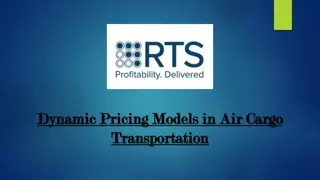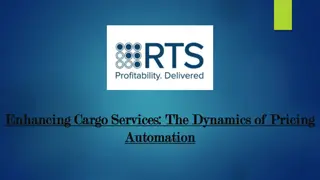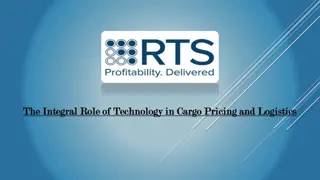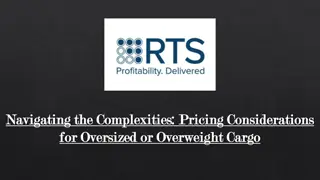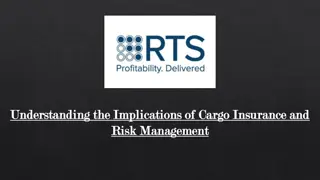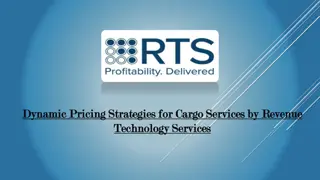Leveraging Cargo and Dynamic Pricing Strategies
In the ever-evolving landscape of global commerce, emerging markets present both substantial challenges and exciting opportunities for businesses. For industries reliant on efficient logistics, such as cargo transportation, developing effective pricing strategies is crucial. This blog will explore the intricacies of cargo pricing and the potential of dynamic pricing in these markets, shedding light on how companies can navigate the complexities and capitalize on the growth opportunities.n
Download Presentation

Please find below an Image/Link to download the presentation.
The content on the website is provided AS IS for your information and personal use only. It may not be sold, licensed, or shared on other websites without obtaining consent from the author.If you encounter any issues during the download, it is possible that the publisher has removed the file from their server.
You are allowed to download the files provided on this website for personal or commercial use, subject to the condition that they are used lawfully. All files are the property of their respective owners.
The content on the website is provided AS IS for your information and personal use only. It may not be sold, licensed, or shared on other websites without obtaining consent from the author.
E N D
Presentation Transcript
Pricing Challenges and Opportunities in Emerging Markets: Leveraging Cargo and Dynamic Pricing Strategies
In the ever-evolving landscape of global commerce, emerging markets present both substantial challenges and exciting opportunities for businesses. For industries reliant on efficient logistics, such as cargo transportation, developing effective pricing strategies is crucial. This blog will explore the intricacies of cargo pricing and the potential of dynamic pricing in these markets, shedding light on how companies can navigate the complexities and capitalize on the growth opportunities.
The Complexity of Cargo Pricing in Emerging Markets Cargo pricing in emerging markets is fraught with challenges, primarily due to the variability and unpredictability inherent in these regions. Several factors contribute to this complexity: 1.Economic Volatility: Emerging markets are often characterized by economic instability. Fluctuating currency values, inflation rates, and economic policies can significantly impact pricing strategies. For instance, a sudden devaluation of the local currency can erode profit margins if prices are not adjusted promptly. 2.Infrastructure Deficiencies: Many emerging markets lack the robust infrastructure found in developed countries. Poor transportation networks, inadequate warehousing facilities, and unreliable utilities can lead to increased operational costs, which must be factored into cargo pricing. 3.Regulatory Environment: Regulatory frameworks in emerging markets can be unpredictable and subject to rapid changes. Compliance with local regulations, tariffs, and customs procedures can add layers of complexity to pricing strategies. 4.Market Demand Fluctuations: Demand for goods and services in emerging markets can be highly volatile. Seasonal variations, political instability, and socio-economic changes can all influence market demand, making it challenging to set stable cargo prices.
Dynamic Pricing: A Strategic Advantage Dynamic pricing, a strategy that involves adjusting prices in real-time based on market demand and supply conditions, offers a promising solution to these challenges. By leveraging technology and data analytics, companies can optimize their pricing strategies to maximize revenue and stay competitive. 1.Real-Time Data Utilization: Dynamic pricing relies on real-time data from various sources, such as market trends, competitor pricing, and consumer behavior. In emerging markets, where conditions can change rapidly, this agility allows businesses to respond swiftly to market shifts. 2.Enhanced Revenue Management: By adjusting prices dynamically, companies can better manage their revenue streams. For instance, during periods of high demand, prices can be increased to capitalize on the opportunity, while during low-demand periods, discounts can be offered to stimulate sales and maintain cash flow. 3.Personalized Pricing: Dynamic pricing enables personalized offers based on customer segments. In emerging markets, where purchasing power varies widely, tailored pricing can attract a broader customer base, enhancing market penetration and customer loyalty. 4.Competitive Edge: Implementing dynamic pricing strategies can provide a significant competitive advantage. Companies that can rapidly adjust their prices to reflect market conditions are better positioned to outmaneuver competitors who rely on static pricing models.
Conclusion Emerging markets offer immense potential for growth, but navigating the pricing challenges requires a strategic approach. By leveraging cargo pricing insights and adopting dynamic pricing strategies, businesses can optimize their operations and capitalize on the opportunities these markets present. Investing in technology, building local expertise, and fostering collaborative partnerships are key to unlocking the full potential of dynamic pricing in these vibrant and diverse markets. As the global economy continues to evolve, the ability to adapt and innovate in pricing will be a critical determinant of success.
THANK YOU THANK YOU




